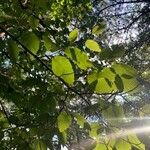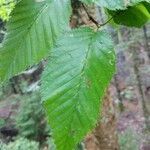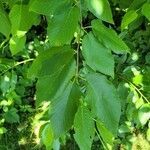Tree to 30 m, the lustrous, yellowish-gray bark exfoliating in thin plates, appearing finely shaggy, eventually becoming dark and roughened in large trees; crushed twigs with the flavor of wintergreen; lvs lance-ovate to ovate, ovate-oblong or somewhat obovate, 6–10 cm, short-acuminate, coarsely and sharply toothed, rounded or subcordate at base, at maturity softly pubescent on the veins beneath, especially in the vein-axils, often paired on short spur-branches; lateral veins mostly 9–12 pairs; fruiting catkins sessile or nearly so, ovoid to short-cylindric, 2–3 cm; scales 6–13 mm, pubescent and ciliate, with ascending or divergent, oblong lobes; frs 2.5–4.5 mm, round-obovoid to subrotund or oblate, the body 1.5–2.5 mm wide, more than half as wide as the whole fr; 2n=84. Moist, chiefly seral woods; Nf. to se. Man., s. to Del., Pa., O., n. Ind., Wis., Minn., and occasionally Io., and along the mts. to n. Ga. (B. lutea)
A medium sized tree. It grows 25 m tall. The trunk is 60 cm across. The bark is yellow-brown and peels off across the trunk. The leaves are oval and 8-11 cm long. The tip is slender and sharp. There are indents or teeth along the edge. They are yellowish green above and lighter underneath. The male or pollen flowers are in catkins 10 cm long and droop. The female or seed catkins are 1.5-2 cm long and erect. The fruit occur in cone-like catkins.




